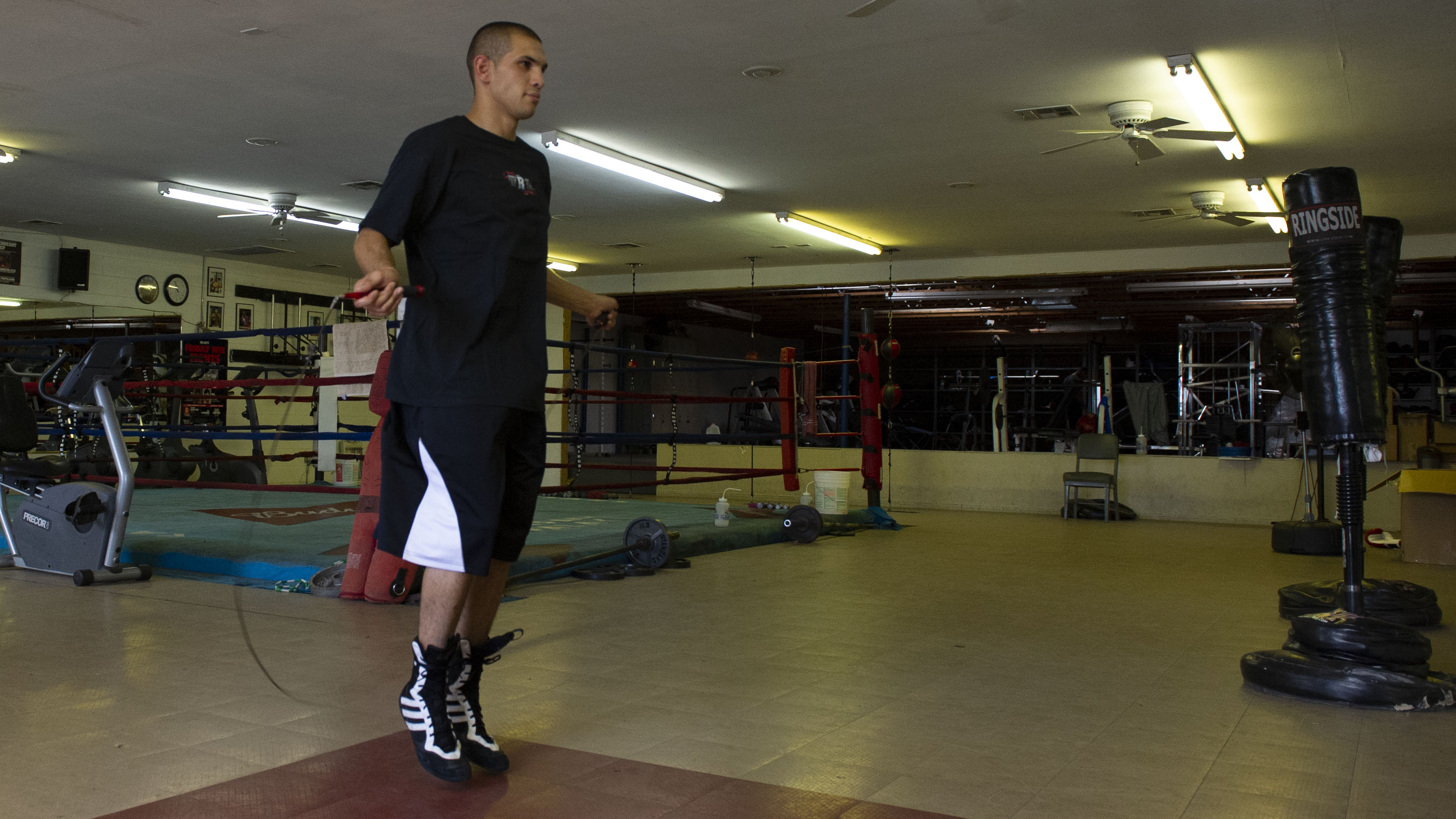If you’ve been around boxing for some time, then you’ve seen fighters jumping rope in the gym. And if you’re just getting started, someone’s probably told you to jump rope as a part of your training. Many of the boxing greats, Ali, Marciano, Tyson, Mayweather, all used the jump rope to get ready for their fights. It’s clear that the jump rope is a fundamental part of the boxing workout. But why?
Obviously, spending 5-10 minutes jumping rope is a great cardio workout, but it’s more than that. Jumping rope can be a great tool for improving your footwork and focusing your mind.
In today’s blog, we’re going to lay out a few reasons that jumping rope is a critical part of your boxing training program. We’ll also help you decide on the right rope for your needs. Finally, we’ll lay out a few jump rope techniques that will challenge and add variety to your routine.
Why Add Jumping Rope to your Boxing Workout?
Better Coordination and Footwork
Jumping rope requires you to master rhythm and timing. It forces you to time your jumps while at the same time spinning a cable around your body at a fast but steady rate. Because of this, it is one of the best tools for improving your overall coordination. If you incorporate a technique like the Boxer’s Skip, you’ll also be taking steps to improve your footwork, as you train your body to rapidly shift weight from one foot to another.
Interestingly, the activity can also help decrease foot and ankle injuries by boosting coordination and helping to strengthen the inner muscles that help keep your feet strong and stable.

Improve your Conditioning
Jumping rope works your whole body. Your legs are working constantly to keep you bouncing over the rope. Your arms and shoulders are spinning a rope around you at constant speed. Your core is engaged to make sure you keep yourself upright. Just like in the ring, when you jump rope, you engage all of your body.
The speed at which you jump rope can also be calibrated to achieve different training goals. Jump at a slower speed if you’re focused on warming up or building endurance. Spin the rope faster, though, and you can work yourself into a high intensity sprint, pushing yourself to your limit for a short time. The ability to vary the speed and intensity of the exercise makes it an ideal tool for dialing in specific conditioning goals.
Develop your Mental Toughness
Keeping your rhythm while spinning a rope around your body looks easy. But to do it well, you need to be 100% present the activity. The moment you let your mind wander away from what you’re doing is the same moment that rope slams into your shins. Or your crossover turns into a mess of tangled rope.
Maintaining awareness of your body and your surroundings with the jump rope, for one minute or ten, translates to your presence in the ring. Knowing where your feet are, how much room you have behind you, and what tactics your opponent favors are all things you need to keep track of during a match. If you’ve trained yourself to be present, even if it’s just on the rope, it will help improve your ability to focus in all your boxing efforts.
Good Warm up for Muscles and Joints
Jumping rope is one of the best warm ups for any boxing workout. The activity itself raises your core temperature without leading to excess fatigue. And when you raise your core temperature you improve your blood flow and increase how efficiently your muscles operate.
Additionally, if your incorporating a lot of different movements into your jump rope routine (see below for some great movements to add), then you’ll be working all the same muscles and joints (hips, ankles, wrists, shoulders, etc.) you’ll be using when you work the bag or spar in the ring. Getting these joints loosened up leaves you better able to punch and move with proper form while avoiding injury.
It’s Easy to Carry With You
One of the best features of the jump rope is that is small, easily portable, and amazingly affordable. You can integrate it into your routine without much effort or investment. You can also take it with you when you have to be on the road, so you can get a good workout in, no matter where you are.
Pick the Right Jump Rope for your Boxing Workout
If you’ve decided to add a training jump rope to your WOD or training routine, you’ll need to decide on which type to get. Like many types of training equipment, jump ropes come in a few varieties.
Beaded Jump Rope
The beaded jump rope is great for beginners. This rope is made of a nylon cord covered with plastic or polyurethane segments, usually about 1.5 inches long. The beads prevent the cord from getting tangled and increase its durability, so you can use it even on rough surfaces. And it makes a loud sound when it hits the ground, making it easier to get into a jumping rhythm.
 Speed Rope
Speed Rope
Made from a thin vinyl cord, the speed rope is lighter and faster than most other ropes. These ropes are easily adjustable by tying a knot in the cord above the handle. Many of the more advanced moves discussed above are easiest to master with a speed rope. These ropes don’t stand up to a lot of abuse and need to be used on soft or smooth surfaces. This makes them ideal for use indoors. On the downside, the thin material makes them prone to getting tangled.
Leather Rope
Slightly thicker and heavier than the speed rope, the leather rope will tangle less while remaining far faster than the beaded option. Many jumpers prefer the leather rope to the speed rope because it’s extra weight allows them to better “feel” the motion of rope going round.
Weighted Ropes
Most of this article focuses on using jump ropes for improving speed and coordination. But weighted ropes have become popular recently for allowing advanced jumpers to improve strength and power as well. There are many varieties of weighted ropes to choose from, but you should only look to move to this style after you’ve mastered the basics.
Adjust the Size
Whatever rope you choose, it won’t be much good if it doesn’t fit you. To size a jump rope, stand on the middle of the rope with one foot. Bring the handles up together against your body, making sure there is no slack in the line. The top of the handles should be:
- Close to the top of your shoulders (for Beginners jumpers)
- Right at the armpit or a little bit below (for Experienced jumpers)
- At the nipple line (for doing Double Unders)
Many ropes are adjustable, allowing you to pull the rope through the handle and cut or tie off the excess. For ropes that are not adjustable, shorten them by tying knots in the line below the handles.
Key Jump Rope Exercises for your Boxing Workout
Here are some of our favorite jump rope exercises to master if you’re looking to add this aerobic essential to your boxing training equipment arsenal. You can combine any and all of these jump rope exercise to create a fun high-intensity routine tailored to you.

Boxer Shuffle
Sometimes referred to as the boxer skip or the boxer step, the boxer shuffle is a super-simple move you can use to improve your footwork and rhythm. You can perform the shuffle with or without a jump rope, but adding the rope helps you sharpen your coordination and also turns the step into a full-body workout.
To do the boxer shuffle, you simple shift your weight from one foot to the other, side to side, every time the rope comes around. It looks a little like you’re hopping from one foot to another. To spice things up, you can add a weighted jump rope to the mix.
Fast Skip
If you want to advance from your basic jump—that is, swinging your rope over the head and hopping with both feet off the ground at the same time—then the fast skip is the perfect next step, as it’s what many advanced tricks are built on. The fast skip is essentially just skipping quickly while you jump, so only one foot is off the ground at any given time.
High-Knee Jumps
High-knee rope jumping takes your everyday jump roping movement and makes it a little more high-intensity. Working to strengthen the leg muscles while burning some serious calories, this exercise requires you to lift your knees high on the jump, working out the muscles in your core and legs.
Crisscross Jumps
After your basic jump, the crisscross jump is one of the simplest ways to skip rope. During this exercise, you start with a basic jump, and then cross your arms—and the rope—every other skip. The benefit of this hop over others is that it helps boost hand-eye coordination and agility. It will also engage your shoulders a bit more into your workout.
Front Back Cross Jumps
Looking to take your rope skipping skills up a few notches? The mesmerizing front back cross jump exercise turns simple jumping into a feat of rhythm and concentration. It requires you to swing the rope to the side in-between jumps, which helps you become more deft and agile.
Side Under Jump
Another impressive trick for building your way to advanced skills, the side under jump requires you to toss the rope to one side and then toss it to the other side before you throw it under your feet. Requiring serious rhythm, quickness, and coordination, this high-intensity jump rope skill is a great one for boxers looking to strengthen their footwork.
Half and Full Twist Jumps
If you’re looking for a way to add the rest of the body to the jumping movement, this is the perfect drill for you. It requires you to twist your body intermittently as you jump, either in a half circle or a full circle. This exercise is perfect for engaging the core and abdominal muscles as you jump.
Start Jumping
Some of these advanced exercises can be very daunting if you’ve never jumped before. But the best way to learn is to start. Begin with the easy exercises until your familiar with the rhythm of jumping rope. Then start to add in more complex options. Eventually, you’ll be able to mix and match exercises (and learn new ones) to turbocharge your coordination. To get serious with your footwork training check out our selection of Jump Ropes, pick your favorite, and start jumping.

